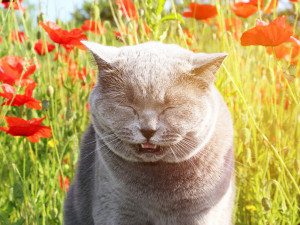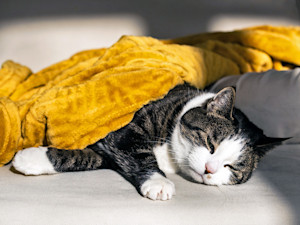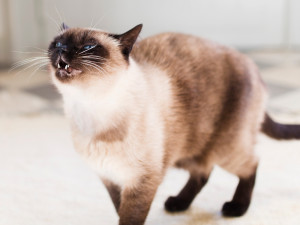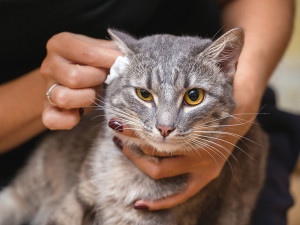Cat Congestion 101: What to Do if Your Cat Sounds Congested
If your cat sounds congested, they probably are. Here’s how you can help them.

Share Article
In This Article:
What Is Cat Congestion?opens in a new tab What Does Cat Congestion Sound Like?opens in a new tab 5 Reasons Why Your Cat Sounds Congestedopens in a new tab Treatment for Your Congested Catopens in a new tab
Coughing, sneezing, a runny nose, and congestion are often parts of the changing seasons, even for our cats. Upper respiratory issues love to find their way into cats, causing many uncomfortable symptoms.
Is your cat experiencing congestion? Figure out why, below, and learn some tips on how to help your kitty feel better.

littleKin™ is Kinship’s home just for puppy and kitten parents. Bop over to check out expert advice, new pet tools, and special deals—all curated for your newest family member.
opens in a new tabMain takeaways
Congestion of the sinuses and nasal passages is fairly common in cats.
Congestion can cause plenty of discomfort along with sneezing, nasal discharge, and difficulty breathing.
Infections, allergies, and foreign objects are often to blame for congestion in cats.
See your veterinarian for treatment if your cat is congested for longer than a couple of days or having difficulty breathing.
What is cat congestion?
If you’re used to congestion as it refers to traffic, you’re not far off what it means to a cat’s airways. Instead of cars crowded together, it’s the swelling in the tissues lining the upper respiratory system and extra mucus that are causing the problem. When cats are congested, their airways become narrowed by inflammation or clogged with mucus, which can make it difficult to breathe, not to mention uncomfortable.
What does cat congestion sound like?
Cat congestion certainly has its own sound and look. For kitties with nasal congestion, you may notice a wheezing or rattling noise as they try to move air through their nose. They may also sneeze or have drainage from their nostrils. Cats may even paw at their face, rub their nose, or breathe through their mouth with nasal congestion.
Sinus congestion in cats may look a little different. They may still have all the signs of nasal congestion, but add to that sinus pain and pressure. The same things that happen to you when your head hurts can happen to your cat. They may have sensitivity to light, may become more withdrawn, or may cry when you touch their head.
5 reasons why your cat sounds congested
Cats are no strangers to the congestion game, but what’s behind it? The answer is many different things.
Upper respiratory infections
Cats can catch coldsopens in a new tab, which, though similar in symptoms to our common cold, are caused by cat-specific microbes. Bacteria, viruses, even fungi love the dark, moist confines of the nasal passages and sinuses. They make perfect breeding grounds, to which the body responds with inflammation and extra mucus production. There are vaccines for many viral causes of congestion, so make sure your cat is up-to-date on their core vaccinesopens in a new tab to prevent infections that could cause congestion.
Dental issues
Infections that lead to congestion don’t have to start in the airways. If you were to look at a feline skull (something most non-veterinary people wouldn’t think of doing), you would see that the molar roots of the upper teeth get awfully close to the borders of the sinuses. Since infections love to grow and share, this means that a tooth infection can extend to the sinuses, creating congestion. Cats will typically have very bad breath and difficulty eating as well. Dental diseaseopens in a new tab is a real issue in cats with more than 50 percent of catsopens in a new tab over the age of four affected, so make sure yours is receiving regular veterinary care to treat and prevent it.
Allergies
While cats cause allergic discomfort in some humans, cats can experience allergies as well. Allergens such as mold, pollen, or dust can lead to congestion, sneezing, watery eyes, and a runny nose. Some may be seasonal, and some may plague your kitty year-round.
Foreign object
A cat’s naturally curious nature can lead to congestion from time to time, especially if they’re sniffing around small objects. Grass seeds, insects, or other things smaller than a cat’s nostril can get inhaled and then stuck in the upper airways, creating an inflammatory response all their own.
Congestion from foreign objects will typically be on one side of the nose, causing discharge and pain in one nostril. Most often these objects have to be removed with a cat under sedation.
Tumors or polyps
The normal lining of the upper airways is smooth and moist — it has to be, for air to move through with the least resistance possible. Occasionally, that smooth surface can get disrupted by lumps or bumps in the form of tumors or polyps. Tumors can be cancerous or non-cancerous, while polyps are simply an overgrowth of mucosal tissue that’s considered benign. Either way, these protrusions create friction, leading to inflammation and congestion.
Long-term congestion may be blamed on a tumor or polyp, which may need to be removed. So see your veterinarian if your cat’s congestion lingers on and on despite treatment.
Treatment for your congested cat
How you get your cat’s airways cleared will depend on the cause of the congestion. Mild congestion may be treated at home, while severe or long-lasting congestion will require a veterinarian’s input.
Home remedies for cat congestion
Your main goal when treating your cat’s congestion is to decrease inflammation and loosen up the mucus. You may be able to do this by reducing allergens in your home with regular cleaning and an air filter. Otherwise, you may loosen mucus by bringing your cat into the bathroom while you take an exceptionally steamy shower — because moist, warm air can break up tough mucus clogs.
When to call your vet for cat congestion
Mild congestion in cats often lasts for just a couple of days. Your cat may eat a little less and sleep with difficulty, but they’ll likely be fine. More severe congestion that is causing breathing difficulty requires a vet visit. You’ll also want to make an appointment if your cat is in pain, not eating, or if this has been going on for a week or more.
Bottom line
The gurgling and wheezing noises that accompany congestion in cats can be caused by several factors, some of which will need to be sorted out by your veterinarian.
Most cases will clear up by themselves in a few days.
More severe cases can cause breathing difficulties. They require a vet visit as soon as possible.
FAQs
What can I do if my cat sounds congested?
Mild congestion may be treated at home by giving your cat a steam bath, where they accompany you to the bathroom as you take a hot shower. Warm, moist air can loosen mucus so that it drains more easily. Nasal congestion can throw off your cat’s appetite, because your cat may not be able to smell their food as well. Offering them canned food may entice them to eat more.
Why does it sound like my cat has a stuffy nose?
If your cat sounds like they have a stuffy nose, they probably have one. Things such as allergies and infections can create congestion in your cat’s nose and sinuses, similar to what you feel when you have a stuffy nose. The congestion is due to inflammation of the linings of the airways and extra mucus production.
How do you treat a congested cat?
Cats with severe or long-term congestion should be seen by a veterinarian, because this can lead to trouble breathing. Mild congestion may resolve on its own without treatment.
What does a cat with respiratory issues sound like?
Most cats breathe naturally with little to no noise. Air moves in and out freely. Cats with congestion or other respiratory issues will make more noise when they breathe. This may include wheezing, gurgling, or rattling. Cats may also struggle to breathe, using their whole body, rather than just their chest, to take a breath.
References
“2020 AAHA/AAFP Feline Vaccination Guidelines.” American Animal Hospital Association. 13 Aug 2020. https://www.aaha.org/resources/2020-aahaaafp-feline-vaccination-guidelinesopens in a new tab.
“Feline Dental Disease.” Cornell Feline Health Center.https://www.vet.cornell.edu/departments-centers-and-institutes/cornell-feline-health-center/health-information/feline-health-topics/feline-dental-diseaseopens in a new tab.
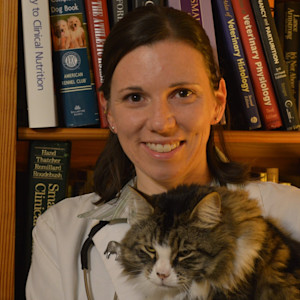
Dr. Chyrle Bonk, DVM
Dr. Chyrle Bonk has been a mixed animal veterinarian since 2010. When she's not practicing or writing about veterinary medicine, you may find her exploring the outdoors with her family or tending to her cows, horses, chickens, or cats and dogs.
Related articles
- opens in a new tab
What to Know About Runny Noses in Cats
Nasal discharge doesn’t sound cute, but you need to know what to look out for.
![Siamese cat in the middle of sneeze]() opens in a new tab
opens in a new tabDid Your Cat Just Sneeze Like a Human Being? Here’s Why
Kitty sneezes can be alarming, but they’re not always cause for concern.
![A cat getting its ear cleaned.]() opens in a new tab
opens in a new tabCat First Aid 101
From performing CPR to preventing shock, three vets break down everything you need to know to help your cat in an emergency.
![Siamese cat coughing]() opens in a new tab
opens in a new tabWhy Is My Cat Coughing?
You thought it was a hairball, but nothing’s coming up…
